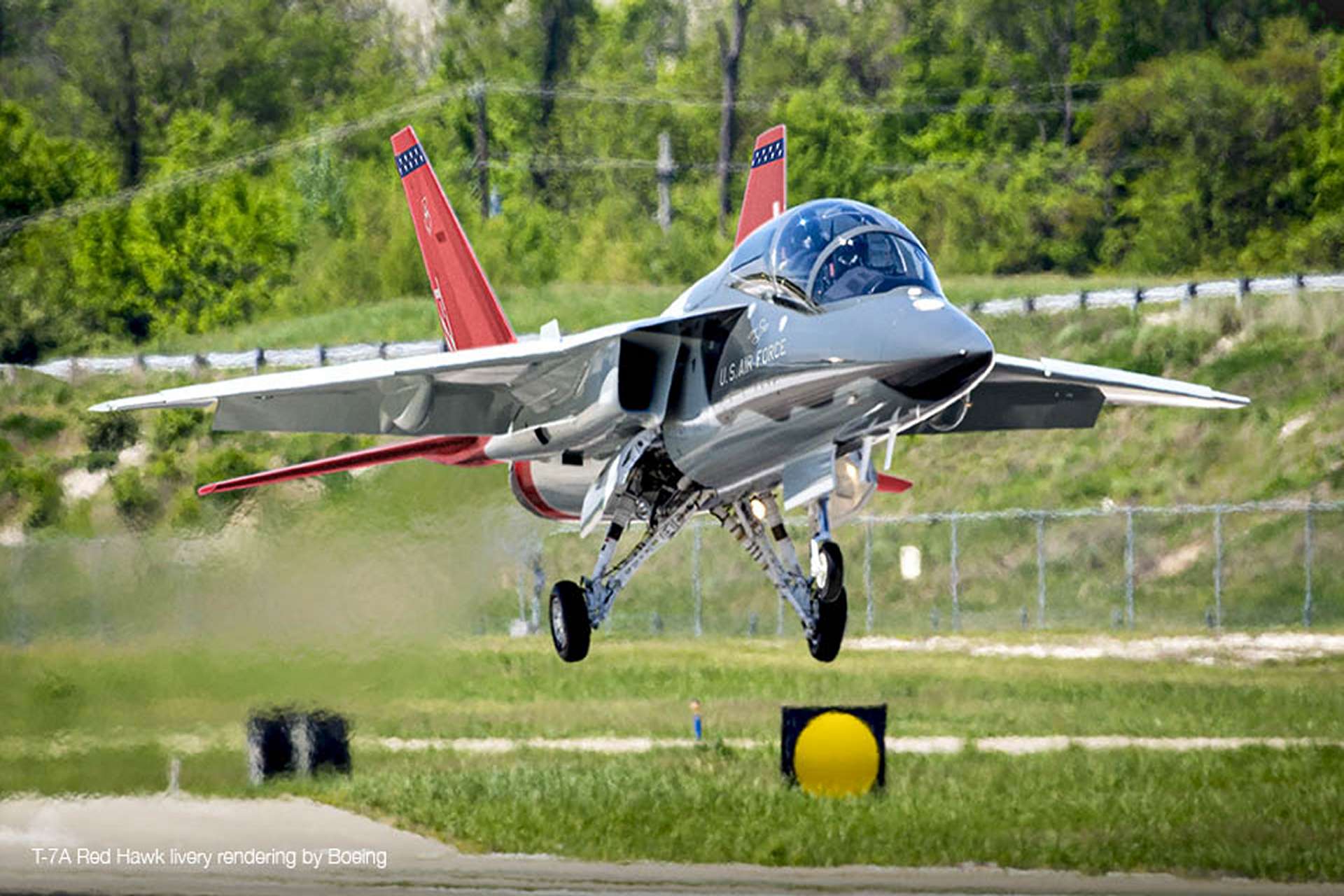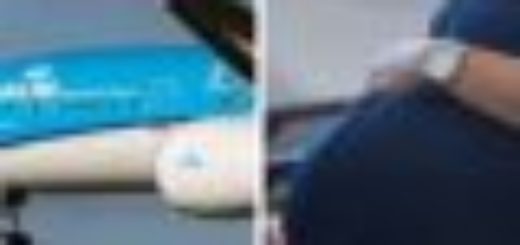Boeing completes final tests of T-7A Red Hawk Jet Trainer before Full-Scale Production

{loadposition bannertop}
{loadposition sidebarpub}
On December 13, 2024, Boeing successfully completed the first flight of the fifth and final Engineering Manufacturing Development (EMD) T-7A Red Hawk aircraft (serial number 21-7005) from its production site in St. Louis, Missouri. Designated APT-5, this aircraft will now join the test fleet operated by the T-7 Integrated Test Force at Edwards Air Force Base, California, where it will undergo further testing to validate its performance and capabilities. This milestone represents a step toward the Milestone C decision and the Low-Rate Initial Production (LRIP) contract, both scheduled for 2025.
Follow Army Recognition on Google News at this link
Boeing T-7A Red Hawk Jet Trainer Aircraft (Picture source: Boeing)
The T-7A Red Hawk program, designed to replace the aging fleet of T-38 Talon aircraft for the U.S. Air Force, has faced delays due to technical challenges, including issues with the ejection seat and “wing rock” instability at high angles of attack during flight testing. Despite these setbacks, Boeing remains committed to meeting the Air Force’s requirements. The integration of the final EMD aircraft into the test fleet will allow for in-depth evaluations of the aircraft’s systems, kinematic characteristics, and mission readiness, ensuring it meets its planned operational performance. Lieutenant Colonel Shay Brantigan, commander of the 416th Flight Test Squadron, emphasized the aircraft’s importance, stating that the T-7 Red Hawk will revolutionize pilot training with advanced systems and capabilities tailored to next-generation combat platforms.
Boeing is also preparing for the LRIP phase by constructing a new production line at its St. Louis facility to ensure delivery readiness. The U.S. Air Force plans to finalize the Milestone C decision by February 2025, with deliveries expected in December 2025, two years behind the original schedule. The $9.2 billion T-X program, awarded to Boeing in 2018, includes the acquisition of 351 T-7A aircraft, 46 simulators, and associated support systems. Designed to emulate fifth-generation fighters like the F-35, the T-7A will facilitate the transition of pilots to modern combat and bomber platforms, addressing the increasing demands for advanced pilot training.
It is also noteworthy that the T-7A Red Hawk is a contender for the U.S. Navy’s Undergraduate Jet Training System (UJTS) program, which seeks to replace the aging T-45 Goshawk training aircraft. Competing alongside the Lockheed Martin-KAI T-50 and Leonardo M-346N, the T-7A’s future with the Navy remains uncertain. The Naval Aviation Enterprise (NAE) is still deliberating key requirements, including the Field Carrier Landing Practice (FCLP), a critical element of pilot training for carrier operations. The outcome of these discussions will influence the Navy’s final choice for the UJTS, as it seeks a next-generation training aircraft capable of effectively preparing aviators for the rigorous demands of carrier-based operations.
The T-7A Red Hawk is an advanced trainer aircraft designed to meet the needs of next-generation pilots. Featuring modern avionics and integrated simulation systems, it offers a human-machine interface similar to that of fifth-generation fighters like the F-22 and F-35. Powered by a GE F404-GE-103 engine delivering 17,200 pounds of thrust (approximately 76.5 kN), the T-7A boasts excellent speed, maneuverability, and acceleration capabilities. Its modular design allows for quick upgrades and simplified maintenance, reducing lifecycle costs. With advanced flight management systems, the T-7A can simulate complex combat scenarios, providing realistic and immersive training for pilots. Its robust airframe is designed to withstand high-G maneuvers, ensuring durability and safety during intensive training sessions.
Developed as part of the U.S. Air Force’s T-X program, launched in 2010 to replace the aging T-38 Talon trainers that have been in service since the 1960s, the T-7A has a rich history. In September 2018, Boeing and Saab were awarded the $9.2 billion contract to produce 351 aircraft, 46 simulators, and support systems. The first prototype, then designated T-X, made its maiden flight in December 2016, followed by a second prototype in April 2017. In July 2019, flight tests for the Engineering and Manufacturing Development (EMD) phase began, marking a critical step in validating the aircraft’s performance. The T-X was officially renamed T-7A Red Hawk in September 2019, honoring the Tuskegee Airmen, the African-American pilots of World War II who flew P-51 Mustangs with red tails.
Following delays caused by technical challenges, including ejection seat concerns and roll instability, the first delivery to the U.S. Air Force took place in September 2023. A decision for Low-Rate Initial Production (LRIP) is now planned for 2025, as Boeing continues to work toward delivering a modern and effective training platform that will shape the next generation of combat pilots.

{loadposition bannertop}
{loadposition sidebarpub}
On December 13, 2024, Boeing successfully completed the first flight of the fifth and final Engineering Manufacturing Development (EMD) T-7A Red Hawk aircraft (serial number 21-7005) from its production site in St. Louis, Missouri. Designated APT-5, this aircraft will now join the test fleet operated by the T-7 Integrated Test Force at Edwards Air Force Base, California, where it will undergo further testing to validate its performance and capabilities. This milestone represents a step toward the Milestone C decision and the Low-Rate Initial Production (LRIP) contract, both scheduled for 2025.
Boeing T-7A Red Hawk Jet Trainer Aircraft (Picture source: Boeing)
The T-7A Red Hawk program, designed to replace the aging fleet of T-38 Talon aircraft for the U.S. Air Force, has faced delays due to technical challenges, including issues with the ejection seat and “wing rock” instability at high angles of attack during flight testing. Despite these setbacks, Boeing remains committed to meeting the Air Force’s requirements. The integration of the final EMD aircraft into the test fleet will allow for in-depth evaluations of the aircraft’s systems, kinematic characteristics, and mission readiness, ensuring it meets its planned operational performance. Lieutenant Colonel Shay Brantigan, commander of the 416th Flight Test Squadron, emphasized the aircraft’s importance, stating that the T-7 Red Hawk will revolutionize pilot training with advanced systems and capabilities tailored to next-generation combat platforms.
Boeing is also preparing for the LRIP phase by constructing a new production line at its St. Louis facility to ensure delivery readiness. The U.S. Air Force plans to finalize the Milestone C decision by February 2025, with deliveries expected in December 2025, two years behind the original schedule. The $9.2 billion T-X program, awarded to Boeing in 2018, includes the acquisition of 351 T-7A aircraft, 46 simulators, and associated support systems. Designed to emulate fifth-generation fighters like the F-35, the T-7A will facilitate the transition of pilots to modern combat and bomber platforms, addressing the increasing demands for advanced pilot training.
It is also noteworthy that the T-7A Red Hawk is a contender for the U.S. Navy’s Undergraduate Jet Training System (UJTS) program, which seeks to replace the aging T-45 Goshawk training aircraft. Competing alongside the Lockheed Martin-KAI T-50 and Leonardo M-346N, the T-7A’s future with the Navy remains uncertain. The Naval Aviation Enterprise (NAE) is still deliberating key requirements, including the Field Carrier Landing Practice (FCLP), a critical element of pilot training for carrier operations. The outcome of these discussions will influence the Navy’s final choice for the UJTS, as it seeks a next-generation training aircraft capable of effectively preparing aviators for the rigorous demands of carrier-based operations.
The T-7A Red Hawk is an advanced trainer aircraft designed to meet the needs of next-generation pilots. Featuring modern avionics and integrated simulation systems, it offers a human-machine interface similar to that of fifth-generation fighters like the F-22 and F-35. Powered by a GE F404-GE-103 engine delivering 17,200 pounds of thrust (approximately 76.5 kN), the T-7A boasts excellent speed, maneuverability, and acceleration capabilities. Its modular design allows for quick upgrades and simplified maintenance, reducing lifecycle costs. With advanced flight management systems, the T-7A can simulate complex combat scenarios, providing realistic and immersive training for pilots. Its robust airframe is designed to withstand high-G maneuvers, ensuring durability and safety during intensive training sessions.
Developed as part of the U.S. Air Force’s T-X program, launched in 2010 to replace the aging T-38 Talon trainers that have been in service since the 1960s, the T-7A has a rich history. In September 2018, Boeing and Saab were awarded the $9.2 billion contract to produce 351 aircraft, 46 simulators, and support systems. The first prototype, then designated T-X, made its maiden flight in December 2016, followed by a second prototype in April 2017. In July 2019, flight tests for the Engineering and Manufacturing Development (EMD) phase began, marking a critical step in validating the aircraft’s performance. The T-X was officially renamed T-7A Red Hawk in September 2019, honoring the Tuskegee Airmen, the African-American pilots of World War II who flew P-51 Mustangs with red tails.
Following delays caused by technical challenges, including ejection seat concerns and roll instability, the first delivery to the U.S. Air Force took place in September 2023. A decision for Low-Rate Initial Production (LRIP) is now planned for 2025, as Boeing continues to work toward delivering a modern and effective training platform that will shape the next generation of combat pilots.






